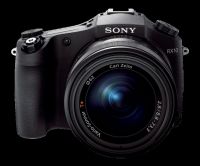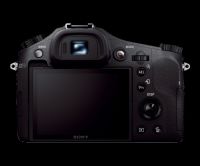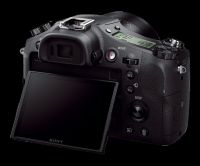Dobrodošli Prijavi se ili Registracija
-
BEOGRAD
063237971
0114045410
0114045411 Pravna lica
-
NOVI SAD
063260828
021522778
Kako do nas? Klikni ovde
SONY DSC-RX10
| Proizvođač: | SONY |
| Šifra Proizvoda: | 4294 |
Sony predstavio RX10
Sony DSC-RX10
Sony have a long history of making interesting cameras and have, in recent years, produced some of the most innovative products and technologies. Not all of these developments have caught on but we've admired their pioneering spirit, even when we haven't always loved the products.
The RX10 combines aspects of two of the company's most imagination-catching cameras - the newly announced RX100 II and the near-legendary R1 from 2005. It revives the large-sensor, long-zoom concept of the R1, but utilizing the same 1"-type BSI CMOS sensor, meaning it can offer a balance of high image quality and long zoom in a sensibly sized package. In this case it means the RX10 is able to offer a 24-200mm equivalent F2.8 lens.
That relatively big sensor means the RX10 is not a small camera - it's about the height and width of a small DSLR and, though its body is slimmer than that, its 8.3x lens adds a stout, weighty bulk to the proceedings.
Sony Cyber-shot DSC-RX10 key features
- 20MP 1"-type BSI CMOS sensor (13.2 x 8.8mm)
- 24-200mm equivalent stabilized F2.8 lens
- Built-in 3-EV Neutral Density filter
- Flip-out, 1.3m dot (VGA resolution) rear LCD
- 1.14m dot OLED viewfinder
- ISO 125 - 12,800 (expandable down to ISO 80)
- Approx 10fps continuous shooting in 'Speed Priority mode'
- Wi-Fi with NFC for easier connection (with compatible devices)
Of course a lot of time has passed since the R1 was launched, so it's no surprise that the RX10 is a more capable camera - but Sony says it has added a lot over even the RX100 II launched earlier this year. By using the same Bionz X processor as the Alpha 7 and 7R, it gains more sophisticated image processing but, significantly, it also gains a built-in 3EV neutral density filter, meaning you can make use of that F2.8 maximum aperture, even in bright light.
The RX10 also becomes the first Sony to feature a 'Direct Drive SSM' focus motor, which uses piezoelectric materials to position the focus element, rather than linear motors. The company says this allows the lens to be both moved and stopped more accurately - reducing focus times. The lens also has a pretty reasonable close-focus distance, that increases from 3cm at the wide-angle end to 30cm at the other extreme (giving magnification ratio of 0.45x and 0.38x respectively).
The more powerful processor not only promises more detailed JPEGs, it also allows the camera to use every pixel to create its video, rather than having to sub-sample the sensor as most DSLRs do (the line-skipping method is a major source of moiré).
And Sony appears to have been thinking about more than just stills when it made this cameras - the RX10 offers one of the most extensive lists of features for videographers we've seen on any camera. This includes stepless aperture control, headphone and mic sockets, focus peaking, zebra exposure warning and uncompressed video output.
The only problem is likely to be trying to convince anyone to spend so much on a compact camera. Because, while it was relatively easy to make the argument that the RX100 was worth nearly twice as much as a Canon S110 (given it had a sensor three times larger) it's a little harder to explain to people why they should pay $1299 for a zoom compact - no matter how capable.
So what's the big deal?
Part of the problem with trying to explain why the RX10 costs so much (and we're not sure why it cost quite so much), is that it requires you to understand not just the equivalent focal length range and aperture, but also the effect of sensor size.
This understanding isn't helped by the use of F-numbers to describe aperture. In terms of exposure (and by definition), F2.8 = F2.8 = F2.8. However, that doesn't tell the whole story. In terms of depth-of-field and total light on the sensor (which is a major determinant of image quality), you also need to consider sensor size - otherwise the 24-200mm equivalent F2.8 lens on this camera doesn't sound any more impressive than a camera half the size or, more importantly, less than half the price.
| Equivalent focal length | Maximum aperture range | Sensor size | Equivalent aperture range | |
|---|---|---|---|---|
| Panasonic DMC-FZ200 | 25-600mm | F2.8 | 1/2.3"-type | F15.5 |
| Nikon Coolpix P7800 | 28-200mm | F2.0 - 4.0 | 1/1.7"-type | F9.5-19 |
| Sony Cyber-shot DSC-RX10 | 24-200mm | F2.8 | 1"-type | F7.6 |
So, while the Panasonic DMC-FZ200 at first glance looks most impressive, the equivalent aperture figures tell a very different story. Equivalent apertures tell you how the lens compares to a full frame lens with similar characteristics - much as the more familiar 'equivalent focal length' does. However, rather than telling you which lens has a comparable field-of-view, it tells you which full frame lens would provide the same control over depth-of-field and the total light hitting the sensor.
So, while it might initially appear that the Nikon Coolpix P7800 offers a comparable lens in a much smaller body (and for much less money), the RX10's actual peers are rather different.
Here you can see that the RX100 can receive around 0.7EV more light at the wide-angle end of its zoom and almost 2.7EV more at the long end of the zoom. In fact, its wide maximum aperture means it's able to receive more light than Canon's larger-sensored G1 X from around 39mm equivalent and more than a Canon DSLR with 18-135mm F3.5-5.6 from 65mm equivalent onwards. And that gives the RX10 greater control over depth-of-field and the potential for better low light performance than any of these cameras.
![]()
|
Conclusion / Recommendation / Ratings are based on the opinion of the reviewer, you should read the ENTIRE review before coming to your own conclusions. Images which can be viewed at a larger size have a small magnifying glass icon in the bottom right corner of the image, clicking on the image will display a larger (typically VGA) image in a new window. To navigate the review simply use the next / previous page buttons, to jump to a particular section either pick the section from the drop down or select it from the navigation bar at the top. DPReview calibrate their monitors using Color Vision OptiCal at the (fairly well accepted) PC normal gamma 2.2, this means that on our monitors we can make out the difference between all of the (computer generated) grayscale blocks below. We recommend to make the most of this review you should be able to see the difference (at least) between X,Y and Z and ideally A,B and C. |
Nazad na kategoriju Prosumer





